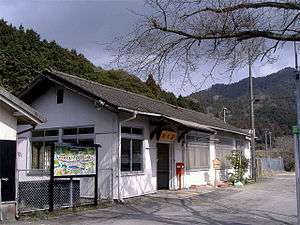Kabuto Station (Mie)
Kabuto Station (加太駅, Kabuto-eki) is a station of the West Japan Railway Company (JR-West) in Kameyama, Mie, Japan.
| JR-West regional rail station | |||||||||||||
 Kabuto Station | |||||||||||||
| Location | 1622, Ichiba, Kabuto, Kameyama (三重県亀山市加太市場1622) Mie Prefecture Japan | ||||||||||||
| Coordinates | 34°50′33″N 136°20′25″E | ||||||||||||
| Owned by | |||||||||||||
| Line(s) |
| ||||||||||||
| Distance | 11.1 km (6.9 mi) from Kameyama | ||||||||||||
| Platforms | 1 side platform and 1 converted side platform | ||||||||||||
| Tracks | 2 | ||||||||||||
| Train operators | |||||||||||||
| Bus stands | 1 | ||||||||||||
| Connections | |||||||||||||
| Construction | |||||||||||||
| Structure type | At grade | ||||||||||||
| Bicycle facilities | |||||||||||||
| Disabled access | None | ||||||||||||
| Other information | |||||||||||||
| Status | Unstaffed | ||||||||||||
| Website | Official website | ||||||||||||
| History | |||||||||||||
| Opened | 21 September 1896 | ||||||||||||
| Traffic | |||||||||||||
| Passengers (2014) | 67 daily | ||||||||||||
| |||||||||||||
| Location | |||||||||||||
 Kabuto Station Location within Japan | |||||||||||||
Lines
Kabuto Station is served by the Kansai Line, and is located 71.1 rail kilometres from the terminus of the Kansai Main Line at Nagoya Station and 11.1 rail kilometres from Kameyama Station.
Layout
The station has a side platform and a converted side platform serving two tracks, connected by an overpass.
History
Kabuto Station was opened on September 21, 1896 with the extension of the Kansai Railway from Yokkaichi Station to Tsuge Station. The Kansai Railway was nationalized on October 1, 1907, becoming part of the Imperial Government Railways (IGR), which became Japan National Railways (JNR) after World War II. Freight operations were discontinued from October 1, 1962. With the privatization of JNR on April 1, 1987, the station came under the control of JR-West.
See also
External links
| Wikimedia Commons has media related to Kabuto Station (Mie). |
- Official website (in Japanese)